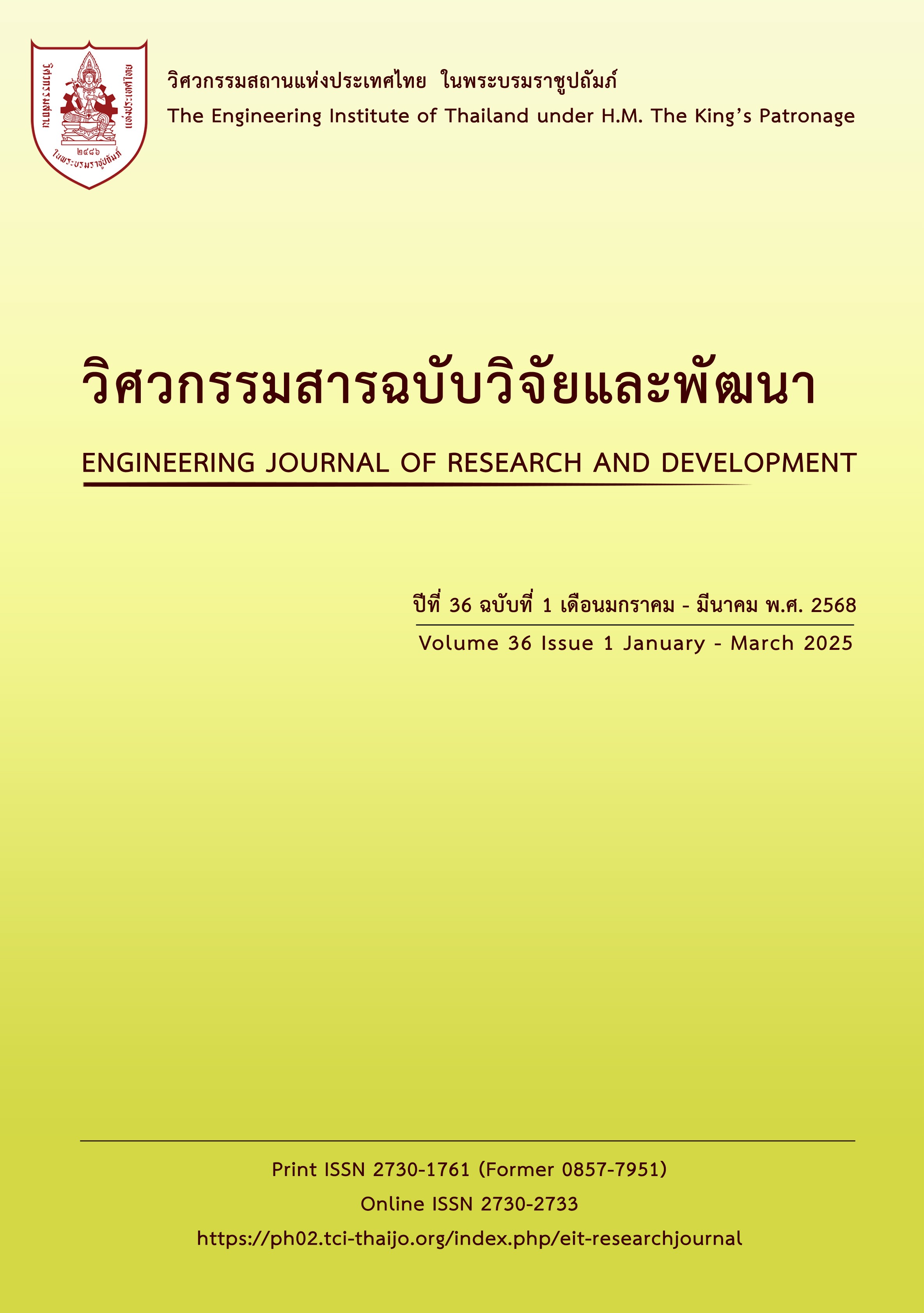การศึกษาปัจจัยเสี่ยงน้ำท่วมด้วยกระบวนการลำดับชั้นเชิงวิเคราะห์พื้นที่ลุ่มน้ำยัง
Main Article Content
บทคัดย่อ
ลุ่มน้ำยังเป็นพื้นที่ที่ประสบปัญหาการเกิดน้ำท่วมซ้ำซาก สาเหตุหลักมาจากสภาพภูมิประเทศบริเวณท้ายน้ำเป็นพื้นที่ราบและความสามารถในการระบายน้ำของลำน้ำต่ำ เมื่อปริมาณน้ำมากในช่วงฤดูฝนส่งผลให้เกิดน้ำล้นตลิ่งเข้าท่วมพื้นที่ชุมชนและพื้นที่การเกษตรได้รับความเสียหาย การศึกษาครั้งนี้ มีวัตถุประสงค์เพื่อประเมินพื้นที่เสี่ยงอุทกภัยของลุ่มน้ำยังตอนล่าง โดยใช้กระบวนลำดับชั้นเชิงวิเคราะห์ (AHP) ร่วมกับระบบสารสนเทศภูมิศาสตร์ (GIS) ในการวิเคราะห์ 6 ปัจจัย ได้แก่ ระดับความสูง การใช้ประโยชน์ที่ดิน ความลาดชัน การระบายน้ำของดิน ปริมาณน้ำฝนเฉลี่ยรายปี และพื้นที่น้ำท่วมซ้ำซาก ผลการศึกษาจะได้พื้นที่เสี่ยงน้ำท่วม โดยแบ่งตามระดับความเสี่ยง 5 ระดับ คือ พื้นที่เสี่ยงน้ำท่วมต่ำมาก 4.929 ตร.กม. คิดเป็นร้อยละ 14.078 พื้นที่เสี่ยง น้ำท่วมต่ำ 4.222 ตร.กม. คิดเป็นร้อยละ 12.059 พื้นที่เสี่ยงน้ำท่วมปานกลาง 6.098 ตร.กม. คิดเป็นร้อยละ 17.417 พื้นที่เสี่ยง น้ำท่วมสูง 9.706 ตร.กม. คิดเป็นร้อยละ 27.722 และพื้นที่เสี่ยงน้ำท่วมสูงมาก 10.057 ตร.กม. คิดเป็นร้อยละ 28.724 ตามลำดับ ผลการวิเคราะห์ได้พื้นที่เสี่ยงน้ำท่วมรายตำบลทั้งหมด 16 ตำบล พบว่า ตำบลบึงเกลือ อำเภอเสลภูมิ จังหวัดร้อยเอ็ด มีพื้นที่เสี่ยงน้ำท่วมมากที่สุด ซึ่งพื้นที่ส่วนใหญ่เป็นพื้นที่ชุมชน และพื้นที่เกษตรกรรม ผลการวิเคราะห์ข้อมูลดังกล่าวสามารถนำมาใช้ประโยชน์ในการวางแผนการบริหารจัดการน้ำในพื้นที่ เพื่อรับมือปัญหาการเกิดอุทกภัย
Article Details

This work is licensed under a Creative Commons Attribution-NonCommercial-NoDerivatives 4.0 International License.
บทความที่ได้รับการตีพิมพ์เป็นลิขสิทธิ์ของวารสารวิศวกรรมสารฉบับวิจัยและพัฒนา วิศวกรรมสถานแห่งประเทศไทย ในพระบรมราชูปถัมภ์
References
Sa-ngiam, N. Pleerux, N. Karnchanasutham, S. and Nualchawee, K. Application of geoinformatics for analysis of flood risk areas in Lower Part of Prachinburi river subbasin. Journal of Social Sciences Srinakharinwirot University. 2016. 21(1), pp. 33-49.
Ruthamnong, S. Geomatics for analysis of flood and drought risk areas in Klong Suan Mak basin, Kamphaeng Phet province. The Golden Teak : Humanity and Social Science Journal (GTHJ), 2017, 23(2), pp. 1-18.
Duangpiboon, S. Suteerasak, T. Rattanakom, R. and Towanlong, W. Flood susceptibility mapping using geographic information system and frequency ratio analysis in the Lang Suan watershed, Southern Thailand, The Journal of King Mongkut’s University of Technology North Bangkok, 2018, 28(2), pp. 259-272. Available from: DOI: 10.14416/j.kmutnb.2018.03.005
Meeching, K. Thongkungand, S. and Suteerasak, T. Application of geographic information system datum data for flood susceptibility area and catchment area assessment: a case study the southern area of SuphanBuri province. The Journal of King Mongkut’s University of Technology North Bangkok, 2019, 29(3), pp. 372-387. Available from: DOI: 10.14416/j.kmutnb.2019.04.001
Promlao, P. and Sornwong, P. A study of factors for the analysis of flood risk areas: a case study of Lower Mun river basin. RSU National Research Conference 2021 on Science and Technology, Rangsit University, Bangkok, Thailand, 30 April 2021, pp. 136-147.
Mangsamong, W. Mamah, I. and Chedoloh. N. Application of geographic information system for analysis of flood risk areas in Kolok river basin, Narathiwat province. The 27th National Convention on Civil Engineering, Chiang Rai, Thailand, 24-26 August 2022, WRE18, pp. 1-6.
Niamthong, D. and Aobpaet, A. Analysis of the risk of flooding in Bangkok and Perimeter. The 28th National Convention on Civil Engineering, Phuket, Thailand, 24-26 May 2023, SGI10, pp. 1-13.
Sulaiman, NA. Mastor, TA. Mat, MSC. and Samad, AM. Flood hazard zoning and risk assessment for Bandar Segamat sustainability using Analytical Hierarchy Process (AHP). IEEE 11th International Colloquium on Signal Processing & Its Applications (CSPA2015), Kuala Lumpur, Malaysia, 6 -8 March 2015, pp. 72-77.
Danumah, JH. Odai, SN. Saley, BM. Szarzynski, J. Thiel, M. Kwaku, A. et al. Flood risk assessment and mapping in Abidjan district using Multi-Criteria Analysis (AHP) model and geoinformation techniques, (cote d’ivoire). Geoenvironmental Disasters, 2016, 3(1), pp. 1-13. Available from: http://dx.doi.org/10.1186/s40677-016-0044-y
Seejata, K. Yodying, A. Wongthadam, T. Mahavik, N. and Tantanee, S. Assessment of flood hazard areas using Analytical Hierarchy Process over the Lower Yom basin, Sukhothai province. ScienceDirect Procedia Engineering, 2018, 212, pp. 340-347. Available from: http://dx.doi.org/10.1016/j.proeng.2018.01.044
Chakraborty, S. and Mukhopadhyay, S. Assessing flood risk using Analytical Hierarchy Process (AHP) and Geographical Information System (GIS): application in Coochbehar district of West Bengal, India. Natural Hazards, 2019, 99(1), pp. 247–274. Available from: http://dx.doi.org/10.1007/s11069-019-03737-7
Montenegro Gambini, J. and Arteta Laymito, J. Multiparametric AHP-based flood hazard zonation approach in northwestern Peru at basin scale. In: 38th IAHR World Congress, Panama, 2019, 1-6 September 2019, 3492, pp. 2320-2330.
Sharir, K. Rodeano, R. and Mariappan, S. Flood Susceptibility Analysis (FSA) using Analytical Hierarchy Process (AHP) model at the Kg. Kolopis area, Penampang, Sabah, Malaysia. Journal of Physics: Conference Series, 2019, 1358(1):012065, Available from: http://dx.doi.org/10.1088/1742-6596/1358/1/012065
Ghezelsofloo, AA. and Hajibigloo, M. Application of flood hazard potential zoning by using AHP Algorithm. Civil Engineering Research Journal, 2020, 9(5), pp. 150-159. Available from: DOI: 10.19080/CERJ.2020.09.555775.
Subbarayan, S. and Sivaranjani, S. Modelling of flood susceptibility based on GIS and Analytical Hierarchy Process - a case study of Adayar river basin, Tamilnadu, India. An Interdisciplinary Approach for Disaster Resilience and Sustainability, Disaster Risk Reduction, 2020, pp. 91-110. Available from: https://doi.org/10.1007/978-981-32-9527-8_6
Kittipongvises, S. Phetrak, A. Rattanapun, P. Brundiers, K. Buizer, JL. and Melnick, R. AHP-GIS analysis for flood hazard assessment of the communities nearby the world heritage site on Ayutthaya Island, Thailand. International Journal of Disaster Risk Reduction, 2020, 48(101612), pp. 1-17. Available from: https://doi.org/10.1016/j.ijdrr.2020.101612
Mujib, MA. Apriyanto, B. Kurnianto, FA. Ikhsan, FA. Nurdin, EA. Pangastuti, EI. et al. Assessment of flood hazard mapping based on Analytical Hierarchy Process (AHP) and GIS: application in Kencong district, Jember regency, Indonesia. Geosfera Indones, 2021, 6(3), pp. 353-376. Available from: DOI : 10.19184/geosi.v6i3.21668
Sharir, K. Lai, GT. Simon, N. Ern, LK. Talip, MA. and Roslee, R. Assessment of flood susceptibility analysis using Analytical Hierarchy Process (AHP) in Kota Belud area, Sabah, Malaysia. In: IOP Conference Series: Earth and Environmental Science, 2022, 1103(1):012005, pp. 1-11. Available from: http://dx.doi.org/10.1088/1755-1315/1103/1/012005
Yodying, A. Mahavik, N. Tantanee, S. Kongmuang, C. Kwadzo Keteku, A. Chidburee, P. et al. A fuzzy AHP approach to assess flood hazard for area of Bang Rakam model 60 project in Yom river basin, Northern Thailand. Applied Environmental Research, 2022, 44(1), pp. 108-125. Available from: https://ph01.tci-thaijo.org/index.php/aer/article/view/248048
Tempa, K. District flood vulnerability assessment using Analytic Hierarchy Process (AHP) with historical flood events in Bhutan. PLoS One , 2022, 17(6):e0270467. pp. 1-20. Available from: http://dx.doi.org/10.1371/journal.pone.0270467
Mokhtari, E. Mezali, F. Abdelkebir, B. and Engel, B. Flood risk assessment using Analytical Hierarchy Process: a case study from the Cheliff-Ghrib watershed, Algeria. Journal of Water and Climate Change, 2023, 14(3), pp. 694–711. Available from: doi: 10.2166/wcc.2023.316
Selvam, RA. and Antony Jebamalai, AR. Application of the Analytical Hierarchy Process (AHP) for flood susceptibility mapping using GIS techniques in Thamirabarani river basin, Srivaikundam region, Southern India. Natural Hazards, 2023, 118(2), pp. 1065–1083. Available from: http://dx.doi.org/10.1007/s11069-023-06037-3
AlAli, AM. Salih, A. and Hassaballa, A. Geospatial-based Analytical Hierarchy Process (AHP) and Weighted Product Model (WPM) techniques for mapping and assessing flood susceptibility in the Wadi Hanifah drainage basin, Riyadh region, Saudi Arabia. Water, 2023, 15(10), 1943, Available from: https://doi.org/10.3390/w1510194

